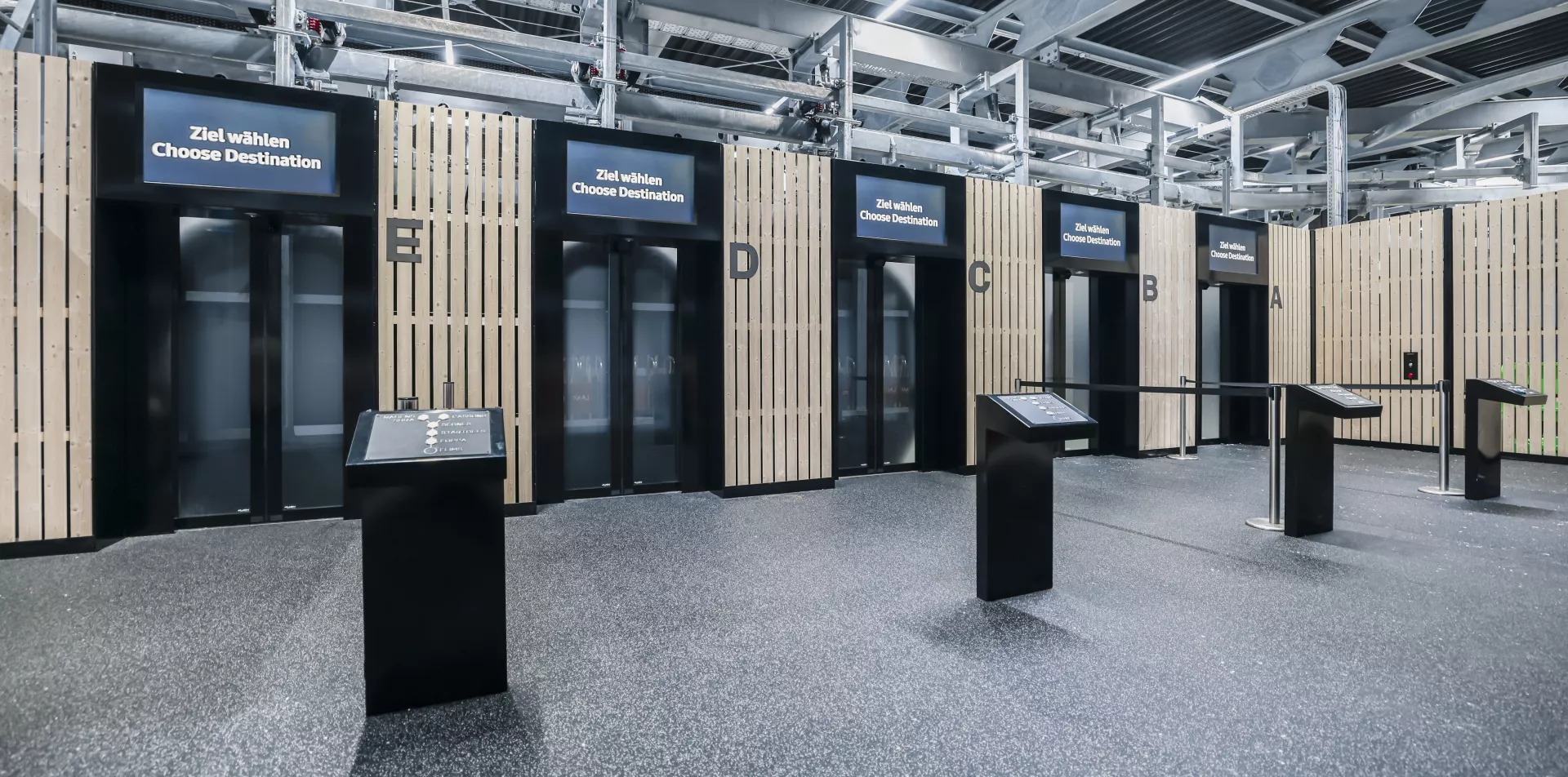Ropetaxi
New Drive System
The operation of a Ropetaxi mono-cable gondola system features the same level of safety and redundancy as a normal urban gondola system. On the line, from point A to point B, the cabins are still transported attached to the cable and also the process of acceleration and deceleration in stations is still carried out by traditional mechanical tire conveyors. However, all cabin movement tire conveyors in the station are eliminated, which allows quiet operation and significantly reduces the number of mechanical parts and their maintenance costs. All that remains is the cabin running rail, which further increases process reliability.
The Ropetaxi system then uses eMotion, the all-new vehicle drive system, to move the cabins in the stations along the rails at a speed of 1 meter/second. The design of the cabin’s cable gripping device employs two redundant electric motor drives with planetary gears for cabin propulsion. The energy supply required for self-propelled operation is provided by regeneration. Kinetic energy is converted into electrical energy and stored during deceleration when the vehicle enters the station and during acceleration when it leaves. The stepless variable speed electrical technology allows the motors to be operated in the ideal power/torque value range.
In addition to the two motors at the gripping device, each vehicle is equipped with two redundant batteries, each allowing autonomous eMotion for up to one hour. The integrated intelligent battery management system (BMS) regulates and observes power and voltage for optimal use of the batteries; the generated energy thus enables a balanced vehicle energy management. Additionally, the batteries can be easily replaced and recharged via a quick-change system. Thanks to the redundancy levels of the eMotion drive, the gondola system operator benefits from maximum availability of the system as well as personal and process safety.
Smart Control System
The process control system enables a networked sequence of all vehicle movements. Intelligent passenger flow allocation with access displays regulates boarding in the correct available cabin. For optimum capacity utilization, the departure is automatically adjusted to the number of passengers, recorded at boarding. Safe cabin entry is provided by double access doors, which are optically monitored as in an elevator. After a cabin has left the boarding area, the vehicles behind automatically move up to the boarding area. This ensures that there is always a vehicle in the passenger entry area. The fast-switching points in the stations are set according to the passenger's choice of local destination or express destinations; through travel without changing cabins is also be realized in this manner.
Each cabin has its own independent control system for the driving motors and monitoring of sensors. In addition, they are equipped with distance sensors to detect other vehicles or objects in the lane autonomously and stop cabins automatically, if necessary. To fully ensure operational safety, a new cabin removal system has been developed that can remove the cabins from the station transit lanes in a short time in case of an in-station failure of any kind.
Autonomous Vehicles
The vehicle acceleration / deceleration area is physically separated from the station boarding and deboarding areas. This allows the cabins to remain at a complete stand still in the boarding and exiting positions. This barrier-free access is comfortable and safe for passengers with wheelchairs, baby strollers, bicycles and luggage, and also allows elderly people to enter without issue. For the first time, an urban gondola system really does justice to people with disabilities and special needs. The cabin interior can be adapted to the individual wishes of the customer, from basic layout to luxury amenities. By automatically tracking each individual vehicle, Ropetaxi can also identify and control specific cabins for local service or express service.
Cabin Storage
Another great advantage of the Ropetaxi system is the possibility to park all vehicles inside the stations to reduce the station area and cabin storage footprint. The space required for the station storage is only slightly larger than for traditional stations, but since there are no longer any separate storage buildings, no separate infrastructure is required. A major time and cost factor to extract cabins from a storage facility is eliminated, as the vehicles are stowed between the loading and unloading areas. As soon as all vehicles are off the line, the entire system can be switched off without having to go through a time-consuming cabin garaging process.
Energy Efficiency
Urban gondolas are already one of the most environmentally friendly means of transportation with a low energy consumption and long service life. An analysis has shown that with the Ropetaxi concept up to 50% of empty vehicle runs can be avoided, as the cabins only get sent to the line when guests are boarding. Thus, only half of the coupling operations take place, resulting in less wear and tear on all equipment and parts. At times when no passengers are transported, the cable speed is automatically reduced. In combination with energy recovery through regeneration, Ropetaxi is characterized by up to 50% lower energy consumption and significantly reduced operating and maintenance costs than traditional aerial gondolas.
Labor Cost Reduction
Due to Ropetaxi’s autonomous passenger boarding/deboarding features with remote platform monitoring, the need for platform attendant labor at every station is greatly reduced or eliminated. Also, with reduced hourly routine maintenance requirements, the amount of maintenance personnel can be reduced compared to traditional gondola maintenance staffing. These labor-saving features, in addition to the before mentioned energy efficiencies, further reduces the annual operating costs of a Ropetaxi urban gondola system.
First Ropetaxi in Flims Laax
Reto Gurtner, Chairman of the Board of Directors of the Weisse Arena Group from Flims Laax Falera, is also enthusiastic about Bartholet's new operating concept and has awarded the contract for the construction of a ropetaxi ropeway with 5 sections. The planning work is in full swing so that the world’s first can go into operation at the touch of a button at the beginning of the 2022/23 winter season.




